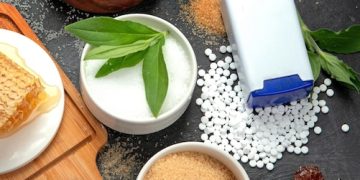Detox Your Body Safely: US Nutritionists’ 7-Day Plan

Achieving a safe and effective body detox involves a balanced, nutritionist-approved 7-day plan focusing on nutrient-rich whole foods, hydration, and gentle lifestyle practices, steering clear of extreme measures.
In today’s fast-paced world, the concept of detoxification, or “detox,” has gained significant traction. Many seek ways to cleanse their bodies from accumulated toxins, hoping for improved energy, better digestion, and overall well-being. But what does it truly mean to Detox Your Body Safely: A 7-Day Plan Approved by US Nutritionists? This article dives deep into a science-backed approach developed by leading US nutritionists, offering a practical guide to safely reset your system without resorting to harsh or unproven methods.
Understanding Detoxification: More Than Just a Trendy Diet
The term “detox” often conjures images of restrictive juice cleanses, unusual supplements, or highly specialized diets. However, according to US nutritionists, true detoxification is a continuous, natural process primarily handled by the body’s own organs: the liver, kidneys, lungs, digestive system, and skin. These organs work tirelessly to neutralize and eliminate harmful substances we encounter daily, from environmental pollutants to metabolic byproducts.
Our focus here isn’t on miracle cures but on supporting these vital organs through nutrition and lifestyle adjustments. This means understanding that a safe detox isn’t about deprivation, but about nourishing your body with the right foods and habits to optimize its inherent cleansing capabilities. It’s about reducing the burden on your system, allowing it to function at its peak efficiency.
The Science Behind Natural Detox
Our bodies are incredibly sophisticated detoxification machines. The liver, for example, performs a two-phase detoxification process: Phase I neutralizes toxins, making them less harmful, and Phase II attaches these neutralized toxins to other molecules, making them water-soluble and easier to excrete. The kidneys filter blood, removing waste products via urine. The digestive system processes food, eliminates solid waste, and maintains a healthy gut microbiome, which plays a crucial role in preventing toxin reabsorption.
Supporting these pathways means consuming ample fiber, antioxidants, and specific nutrients that fuel these enzymatic processes. It also means minimizing exposure to external toxins found in processed foods, certain chemicals, and pollutants. This holistic view provides a foundation for a truly effective and safe detox plan that respects the body’s natural wisdom.
For many, the allure of a quick fix is strong, but a sustainable approach is always preferable for long-term health benefits. This plan emphasizes a gentle and gradual shift, acknowledging that abrupt changes can sometimes do more harm than good.
Preparing Your Body and Mind for the 7-Day Detox
Before embarking on any significant dietary or lifestyle change, preparation is key. This 7-day detox plan isn’t a sudden jolt but a supportive transition. A few days before you begin, consider gradually reducing your intake of caffeine, refined sugars, processed foods, and alcohol. This pre-detox phase can help minimize withdrawal symptoms like headaches or fatigue that sometimes accompany a shift to cleaner eating.
Clearing Your Pantry and Mindset
- Stock Your Kitchen: Fill your pantry and refrigerator with fresh, whole foods. Think organic fruits and vegetables, lean proteins, healthy fats, and whole grains. Eliminate tempting processed snacks, sugary drinks, and anything that doesn’t align with the plan.
- Hydration Priority: Invest in a good water bottle and commit to consistent hydration. Water is fundamental to flushing out toxins. Consider adding lemon or cucumber slices for flavor and added benefits.
- Set Realistic Expectations: Understand that this is a journey towards better health, not a magic bullet. Be patient with your body and listen to its signals. Focus on the positive changes you’re making, rather than potential temporary discomforts.
Mental preparation is just as important as physical. Embrace the idea that you are nourishing your body and supporting its natural functions. This positive mindset can significantly impact your experience and adherence to the plan. Journaling about your progress and feelings can also be a powerful tool for self-awareness during this period.
Remember, consult with your healthcare provider or a registered dietitian before starting any new dietary regimen, especially if you have underlying health conditions or are taking medications. This step ensures that the plan is appropriate and safe for your individual needs.
The 7-Day Detox Plan: Day-by-Day Guide (US Nutritionist Approved)
This 7-day plan outlines a general framework focusing on nutrient-dense foods, adequate hydration, and gentle practices. It is flexible and encourages listening to your body.
Days 1-2: Reset and Hydrate
The initial days focus on removing common dietary burdens and increasing fluid intake. This helps your body ease into the detoxification process without feeling overwhelmed.
- Morning: Start with a glass of warm lemon water. Breakfast could be a green smoothie with spinach, banana, almond milk, and a scoop of plant-based protein.
- Mid-day: A large salad with leafy greens, colorful vegetables, and a light vinaigrette. Opt for grilled chicken or lentils for protein.
- Evening: Steamed vegetables with a piece of baked fish or quinoa. Aim for an early dinner to give your digestive system ample rest.
- Throughout the day: Drink at least 8-10 glasses of filtered water. Herbal teas (ginger, peppermint, dandelion) are also beneficial.
During these first two days, you might experience mild headaches or fatigue as your body adjusts. This is often a sign of caffeine or sugar withdrawal. Rest, stay hydrated, and be kind to yourself. Focus on whole, unprocessed foods and avoid anything artificial.
Days 3-4: Nourish and Replenish
As your body adapts, these days focus on providing essential nutrients to support liver function and gut health. Incorporate a wider variety of detox-friendly foods.
- Emphasize cruciferous vegetables: Broccoli, cauliflower, Brussels sprouts, and kale contain compounds that support liver detoxification enzymes.
- Introduce fermented foods: A small serving of sauerkraut, kimchi, or plain unsweetened yogurt (if dairy is tolerated) can help promote a healthy gut microbiome.
- Healthy fats: Include avocados, nuts, seeds, and olive oil to provide essential fatty acids that support cell repair and reduce inflammation.
Consider adding a handful of berries to your breakfast or as a snack; their antioxidant content is excellent for cellular health. Remember that portion control still matters, even with healthy foods. The goal is nutrient density, not excessive consumption.
Essential Nutrients and Foods for Effective Detoxification
Certain nutrients play a critical role in supporting the body’s natural detoxification pathways. By strategically including these in your diet, you empower your organs to work more efficiently.
Antioxidants: Your Body’s Protectors
Antioxidants like vitamins C and E, selenium, and various phytonutrients found in plants help combat oxidative stress caused by toxins. Oxidative stress can damage cells, and antioxidants neutralize these harmful free radicals.
- Berries: Blueberries, strawberries, raspberries are packed with antioxidants.
- Leafy Greens: Spinach, kale, collard greens offer a wide spectrum of vitamins and minerals.
- Colorful Vegetables: Bell peppers, carrots, sweet potatoes are rich in beta-carotene and other antioxidants.
Incorporating a rainbow of fruits and vegetables ensures you get a diverse array of these protective compounds. Cooking methods that preserve nutrient content, such as steaming or light sautéing, are preferable.
Fiber: The Gut’s Best Friend
Dietary fiber is crucial for gut health and effective waste elimination. It adds bulk to stool, facilitating regular bowel movements and preventing toxins from being reabsorbed into the bloodstream.
Foods rich in fiber:
- Whole grains: Oats, brown rice, quinoa.
- Legumes: Lentils, beans, chickpeas.
- Fruits: Apples, pears (with skin), berries.
- Vegetables: Artichokes, broccoli, Brussels sprouts.
Gradually increasing fiber intake can help avoid digestive discomfort. Adequate water intake is also essential when consuming more fiber, as it helps move the fiber through your system smoothly. A healthy gut is a cornerstone of effective detoxification.

Lifestyle Practices to Complement Your Detox Journey
Detoxification isn’t solely about what you eat; it’s also about how you live. Incorporating supportive lifestyle practices can significantly enhance the effectiveness and comfort of your 7-day plan.
Prioritizing Sleep and Stress Management
Sleep is a critical period for cellular repair and regeneration, including the processes involved in detoxification. Aim for 7-9 hours of quality sleep per night. Chronic stress, on the other hand, can burden the body, affecting hormonal balance and digestive function.
- Mindfulness and Meditation: Even 10-15 minutes daily can help calm the nervous system.
- Deep Breathing Exercises: Simple breathwork can reduce stress levels and promote relaxation.
- Limit Screen Time Before Bed: Blue light from devices can disrupt melatonin production, impacting sleep quality.
Creating a relaxing bedtime routine can signal to your body that it’s time to wind down. This might include a warm bath, reading a book, or listening to calming music. Managing stress directly impacts your body’s ability to maintain equilibrium and process waste effectively.
Movement and Hydration
Physical activity, even gentle forms, stimulates circulation and lymphatic flow, which are vital for moving waste products out of the body. Sweating through exercise can also aid in toxin elimination via the skin.
- Daily Walks: Aim for at least 30 minutes of brisk walking.
- Yoga or Stretching: These promote flexibility and help reduce muscle tension, enhancing overall well-being.
- Adequate Water Intake: Beyond just flushing toxins, water is essential for every bodily function, including nutrient transport and temperature regulation.
Remember that a detox doesn’t necessarily mean intense workouts. Gentle movement is often more beneficial during a cleansing period. Listen to your body and choose activities that feel rejuvenating rather than draining. Consistent hydration remains paramount throughout your detox journey and beyond.
Addressing Common Questions and Misconceptions About Detox
“Detox” is a buzzword, and with it come numerous claims, some evidence-based, others not. Understanding what is realistic and what is not essential for a safe and effective approach.
Are Detox Teas and Supplements Necessary?
Often, “detox” products promise rapid results but lack scientific backing. Many detox teas contain laxatives or diuretics that can lead to dehydration and electrolyte imbalances, rather than true detoxification. Similarly, most detox supplements are unnecessary if you are consuming a whole-foods diet rich in nutrients.
The human body is remarkably efficient at detoxification when supported correctly. Focus on nutrient-dense foods, sufficient hydration, sleep, and stress management. These foundational elements provide far more benefit than any commercial detox product. Consult a healthcare professional before taking any new supplements, particularly during a detox period, to ensure safety and avoid potential interactions.
Understanding “Die-Off” Symptoms
As your body adjusts to a cleaner diet, you might experience temporary symptoms often referred to as “detox” or “die-off” symptoms. These can include headaches, fatigue, mild digestive upset, or skin breakouts. These symptoms are usually mild and indicative of your body adjusting. However, severe symptoms warrant immediate consultation with a healthcare provider.
These temporary discomforts are not a sign that you are “ridding” toxins rapidly, but rather that your body is adapting to new metabolic processes. Staying well-hydrated, resting, and maintaining a consistent intake of supportive nutrients can help alleviate these effects. The duration and intensity of these symptoms vary greatly from person to person.
It’s important to differentiate between temporary adjustment discomfort and genuine adverse reactions. While minor discomfort is common, prolonged or severe symptoms are not. This is why a gradual transition and professional guidance are always recommended.

Maintaining a Clean Lifestyle Beyond 7 Days
The 7-day detox plan is not an end in itself, but rather a springboard for adopting more sustainable, health-promoting habits. The goal is to integrate the principles of clean eating and supportive lifestyle practices into your daily life for long-term well-being.
Gradual Reintroduction and Mindful Eating
After the 7 days, you might consider slowly reintroducing foods you temporarily removed, one at a time. This allows you to observe how your body reacts and identify any foods that might cause sensitivities or discomfort. This mindful reintroduction process is invaluable for understanding your body’s unique dietary needs.
- Listen to Your Body: Pay attention to how different foods make you feel – in terms of energy, digestion, mood, and skin health.
- Prioritize Whole Foods: Continue to emphasize fruits, vegetables, lean proteins, and whole grains as the foundation of your diet.
- Mindful Eating: Eat slowly, chew thoroughly, and savor your meals. This improves digestion and helps you recognize satiety cues, preventing overeating.
Developing a mindful relationship with food goes beyond just what you eat; it’s about how you eat. This practice can prevent the return of unhealthy eating patterns and help maintain the benefits gained during the detox period.
Long-Term Health Habits
The principles learned during the detox can become permanent pillars of your healthy lifestyle:
- Consistent Hydration: Make drinking adequate water a daily habit.
- Regular Movement: Continue to incorporate physical activity that you enjoy.
- Sustainable Stress Management: Keep practicing techniques that help you relax and de-stress.
- Limit Processed Foods and Sugar: Reserve these for occasional treats rather than daily staples.
- Adequate Sleep: Prioritize 7-9 hours of quality sleep every night.
By making these shifts, you continuously support your body’s natural detoxification processes without needing frequent, intense “cleanses.” This approach promotes consistent wellness and resilience against modern environmental challenges, ensuring your body functions optimally for years to come. The emphasis is on building a robust, resilient system, rather than relying on periodic resets.
| Key Point | Brief Description |
|---|---|
| 🍎 Whole Foods Focus | Emphasize fresh fruits, vegetables, lean proteins, and whole grains to support natural bodily functions. |
| 💧 Hydration is Key | Drink plenty of filtered water and herbal teas to aid toxin elimination. |
| 🧘♂️ Lifestyle Support | Incorporate adequate sleep, stress reduction, and gentle movement for holistic well-being. |
| 🚫 Avoid Extremes | Steer clear of aggressive cleanses or unproven supplements; focus on supporting natural processes. |
Frequently Asked Questions About Safe Body Detox
In a nutritionist’s view, detoxification refers to supporting the body’s natural cleansing organs—like the liver and kidneys—through optimal nutrition and healthy lifestyle habits. It’s about enhancing the body’s inherent ability to neutralize and eliminate toxins, rather than relying on external, often unproven, cleansing products or extreme diets.
Yes, it’s relatively common to experience some fatigue or mild headaches during the initial days of a dietary shift. This can be due to reduced caffeine or sugar intake, as your body adjusts to new eating patterns. These symptoms typically subside as your system adapts, highlighting the importance of rest and hydration.
No, this nutritionist-approved 7-day detox plan emphasizes whole foods and natural hydration, not expensive or specialized supplements. The focus is on providing your body with the essential nutrients it needs to perform its natural detoxification processes efficiently through a balanced diet, making additional supplements largely unnecessary.
While movement is encouraged, intense exercise might be too demanding during a detox, especially in the initial days. Opt for gentle activities like walking, yoga, or stretching. The goal is to support your body’s cleansing processes without adding extra stress. Listen to your body and adjust activity levels accordingly to ensure comfort and effectiveness.
After the 7-day plan, gradually reintroduce foods while observing your body’s reactions. Continue to prioritize whole, unprocessed foods like fresh fruits, vegetables, lean proteins, and whole grains. The aim is to establish sustainable healthy eating habits that support your body’s natural functions long-term, rather than reverting to old patterns.
Conclusion
Embarking on a safe body detox, guided by a nutritionist-approved 7-day plan, is fundamentally about empowering your body’s innate cleansing abilities. It’s a journey that moves beyond fleeting trends and promotes deep cellular nourishment, consistent hydration, balanced lifestyle choices, and a truly holistic approach to wellness. By embracing the principles of whole-food nutrition, conscious living, and understanding your body’s signals, you’re not just completing a temporary cleanse; you’re cultivating sustainable habits that foster long-term vitality and resilience. This comprehensive strategy ensures that you’re supporting your health safely and effectively, laying the groundwork for a lighter, more energetic you, well beyond the initial seven days.





